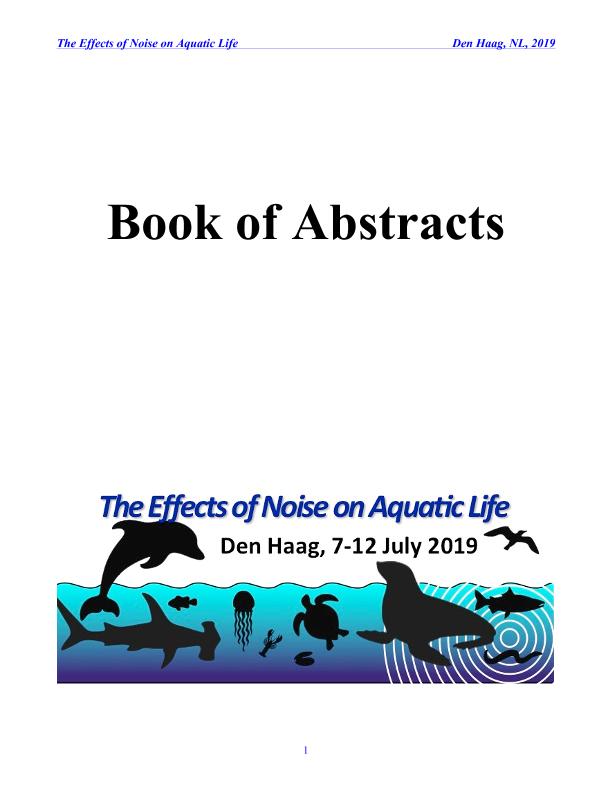Evento
Effects of water gun on echinoderms: biochemical changes on sea Urchin (Arbacia lixula) and sea Cucumber (Holothuria tubulosa)
Buscaino, Giuseppa; Ceraulo, Maria; Giacalone, Vincenzo Maximiliano; Papale, Elena; Gregorietti, Martina; Mazzola, Salvatore; Grammauta, Rosario; Sal Moyano, María Paz ; Di Fiore, Vincenzo; Dioguardi, Maria; Mauro, Manuela; Celi, Mónica; Vazzana, Mirella
; Di Fiore, Vincenzo; Dioguardi, Maria; Mauro, Manuela; Celi, Mónica; Vazzana, Mirella
 ; Di Fiore, Vincenzo; Dioguardi, Maria; Mauro, Manuela; Celi, Mónica; Vazzana, Mirella
; Di Fiore, Vincenzo; Dioguardi, Maria; Mauro, Manuela; Celi, Mónica; Vazzana, Mirella
Tipo del evento:
Congreso
Nombre del evento:
The effects of noise on aquatic life
Fecha del evento:
07/07/2019
Institución Organizadora:
Acoustic Society of America;
Título del Libro:
Book of abstracts: The Effects of Noise on Aquatic Life
Editorial:
Aquatic Noise
Idioma:
Inglés
Clasificación temática:
Resumen
Sources Airguns and Waterguns are used in seismic exploration the marine seafloor for different purposes such as oil and gas search, or geological-geodynamic reconstruction. In this technique a bubble of compressed air is produced with a consequently production of loud sound wave penetrating the ocean floor. The impact of seismic Airguns was assessed in some cetaceans (Kyhn et al. 2019), fish species and invertebrate (Carroll et al. 2017), but we need to know more. In this study we evaluate the biochemical changes in sea urchin (Arbacia lixula) and sea cucumber (Holothuria tubulosa) exposed to a 20 minutes of watergun noise (1 pulse each 10 s) at a distance of 50 m. For each species 40 individuals were captured and caged in the sea in groups of 10. After four days of acclimation we started the experimental test that previewed these 4 samplings phases: T0-control group before the Watergun sound exposition; T1-post group soon after the end of sound exposition; T2-post group after 3 hour of exposition; T3- post group after 24 hour of exposition. Watergun pulse was characterized by measuring pressure (SM2U, Wildlife Acoustics) and particle speed (M20- 105, Geospectrum) in the three dimensions at the same position of the caged animals. Watergun pulses Power Spectral Density for pressure and particle speed showed respectively a peak of 122 dB re1µPa2 /Hz at 850 Hz and a peak of 207 dB re(1nm/s)2 at 550 Hz for x component (direction parallel to the sea surface and forward the caged animals). The coelomatic fluid was extracted by each animal for the following successive analysis: total volume withdrawn, Total Hemocytes Counts (THC), total protein, phosphatase, esterase and peroxidase activity. In the sea urchin we observed significant differences in esterase (T0 < T2 and T3), and peroxidase (T0 < T2 and T3). Concerning sea cucumber we found significant differences for THC (T0 T2; T1 < T2). This is the first attempt to study the effects of a short loud low frequencies sound exposition in echinoderms species and results show that these animals reacted to the noise with an alteration of some coelomic fluid parameters indicators of stress.
Palabras clave:
WATER GUN
,
BIOCHEMICAL
,
INVERTEBRATES
Archivos asociados
Licencia
Identificadores
Colecciones
Eventos(IIMYC)
Eventos de INSTITUTO DE INVESTIGACIONES MARINAS Y COSTERAS
Eventos de INSTITUTO DE INVESTIGACIONES MARINAS Y COSTERAS
Citación
Effects of water gun on echinoderms: biochemical changes on sea Urchin (Arbacia lixula) and sea Cucumber (Holothuria tubulosa); The effects of noise on aquatic life; La Haya; Países Bajos; 2019; 18-18
Compartir



